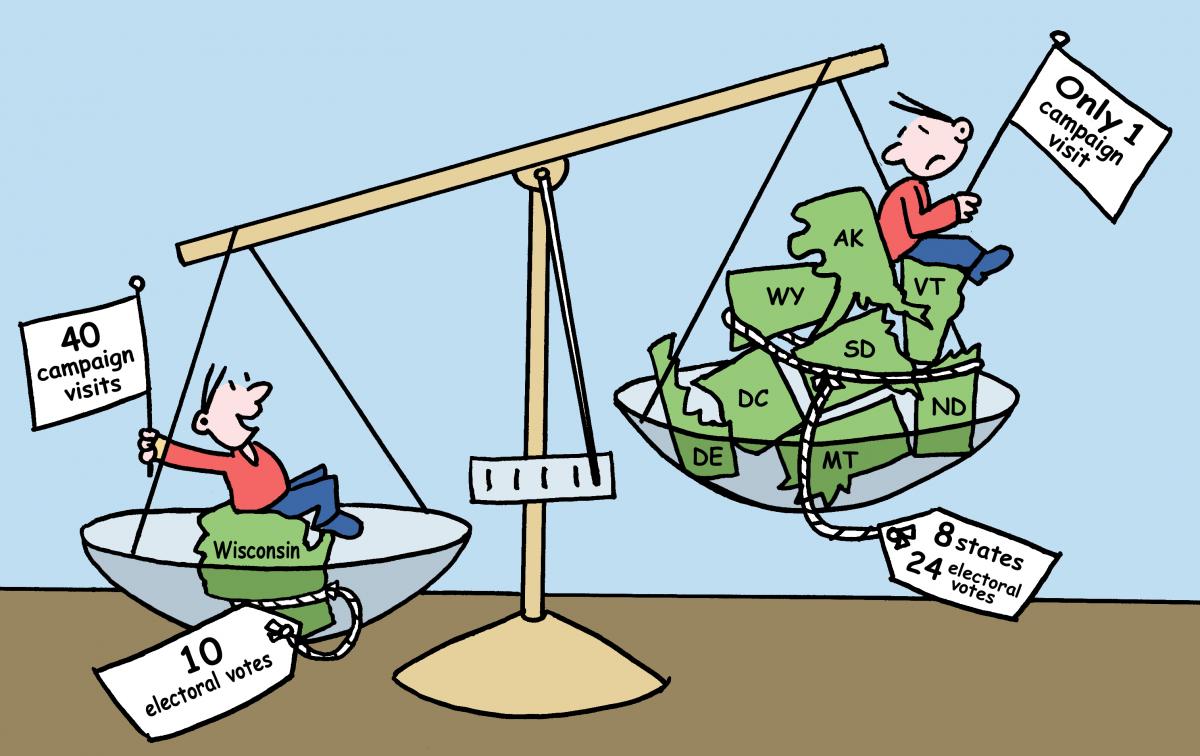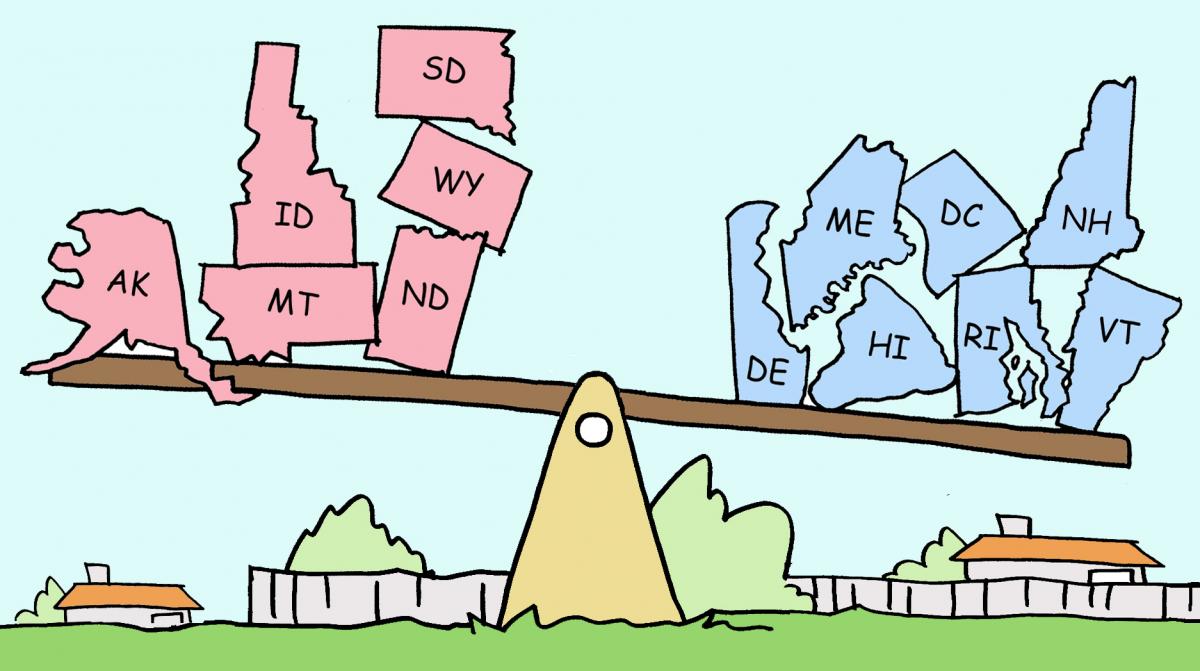Click here for detailed memo on small states.
We've all heard that low-population states are especially influential in electing the President because each state gets extra electoral votes corresponding to their Senators.
Small States Do Not Have Disproportionate Influence in Picking the President, but, instead, have Virtually No Influence because They are One-Party States in Presidential Elections
However, the political reality is that the current system decreases the political clout of small states in presidential elections.
Far from being “protected,” the eight smallest states are the most disadvantaged and ignored group of states under the current state-by-state winner-take-all method of awarding electoral votes.

There were 952 general-election campaign events during the 2008, 2012, and 2016 presidential campaigns. However, only one of these 952 events occurred in the eight smallest states. As can be seen from the table, seven of the eight smallest states were totally ignored in all three elections. The District of Columbia received one isolated event in 2008.
Number of general-election campaign events in 2008, 2012, and 2016 in the 8 smallest states (3 electoral votes)
|
EV |
State |
2008 events |
2012 events |
2016 events |
Population |
|
3 |
Wyoming |
|
|
|
568,300 |
|
3 |
D.C. |
1 |
|
|
601,723 |
|
3 |
Vermont |
|
|
|
630,337 |
|
3 |
North Dakota |
|
|
|
675,905 |
|
3 |
Alaska |
|
|
|
721,523 |
|
3 |
South Dakota |
|
|
|
819,761 |
|
3 |
Delaware |
|
|
|
900,877 |
|
3 |
Montana |
|
|
|
994,416 |
|
24 |
Total |
1 |
0 |
0 |
5,912,842 |
The population of the eight smallest states (5,912,842) is slightly larger than the population of Wisconsin (5,698,230). Because of the bonus of two electoral votes that every state receives, the eight smallest states have 24 electoral votes—compared to only 10 for Wisconsin. Yet Wisconsin received 40 general-election campaign events in these three elections. That is, Wisconsin received 40 times more general-election campaign events as the eight smallest states even though the eight smallest states have 2.4 times as many electoral votes as Wisconsin.
Presidential candidates ignore the smallest states—not because they are small—but because they are predictable one-party states in presidential elections. Under the current state-by-state winner-take-all method of awarding electoral votes, political power and attention comes from being a closely divided battleground state -- not from a state's number of electoral votes. Wisconsin's 10 electoral votes attract 40 times more attention than the 24 electoral votes of the eight smallest states.
The reason why the small states are ignored in presidential campaigns becomes clear if we expand the discussion to the 13 smallest states (i.e., states with three or four electoral votes).
Number of general-election campaign events in 2008, 2012, and 2016 in the 13 smallest states (3 or 4 electoral votes)
|
EV |
State |
2008 events |
2012 events |
2016 events |
Population |
|
3 |
Wyoming |
|
|
|
568,300 |
|
3 |
D.C. |
1 |
|
|
601,723 |
|
3 |
Vermont |
|
|
|
630,337 |
|
3 |
North Dakota |
|
|
|
675,905 |
|
3 |
Alaska |
|
|
|
721,523 |
|
3 |
South Dakota |
|
|
|
819,761 |
|
3 |
Delaware |
|
|
|
900,877 |
|
3 |
Montana |
|
|
|
994,416 |
|
4 |
Rhode Island |
|
|
|
1,055,247 |
|
4 |
New Hampshire |
12 |
13 |
21 |
1,321,445 |
|
4 |
Maine |
2 |
|
3 |
1,333,074 |
|
4 |
Hawaii |
|
|
|
1,366,862 |
|
4 |
Idaho |
|
|
|
1,573,499 |
|
44 |
Total |
15 |
13 |
24 |
12,562,969 |
As can be seen from the table, 10 of the 13 smallest states were totally ignored in all three elections. However, one of the 13 smallest states (New Hampshire) received a considerable amount of attention—46 of the 52 of the campaign events (88%) in these three elections. Maine received a modest amount of attention—a total of five of the 52 events over two particular elections.
The reason why New Hampshire received so much attention is that it was a closely divided battleground state in these three elections. The Democratic nominee received 55%, 53%, and 50.2% of the two-party vote in 2008, 2012, and 2016, respectively. Thus, both parties campaigned vigorously in New Hampshire because each perceived (correctly) that they had something to gain by campaigning in the state and something to lose if they didn’t. Note that the candidates campaigned unusually vigorously in New Hampshire in 2016 when the race was far closer (50.2%) than in 2008 or 2012. There were 21 events in 2016, compared to only 12 and 13 events in 2008 and 2012, respectively.
Maine received two events in 2008 and three in 2016 because Maine awards electoral votes by congressional district. The Democratic nominee easily won the non-competitive 1st district in 2008, 2012, and 2016 and easily won the state as a whole in all three elections. That is, the state as a whole was not competitive. However, Maine’s 2nd district was closely divided in two of these three elections (2008 and 2016). Because the presidential candidates perceived (correctly) that they had something to gain or lose in Maine’s 2nd district in those particular elections, they campaigned there. Indeed, Donald Trump carried Maine’s 2nd district in 2016 and thereby won one electoral vote from Maine.
The 12 small non-battleground states in the table above have a combined population of 11,241,524. Coincidentally, Ohio has almost the same number of people as these 12 small states (11,568,495). Because of the bonus of two electoral votes that every state receives, the 12 small non-battleground states have 40 electoral votes, whereas Ohio has only half as many. However, under the state-by-state winner-take-all method of awarding electoral votes, political power does not arise from the number of electoral votes that a state possesses, but instead, from whether the state is a closely divided battleground state. In 2012, the closely divided battleground state of Ohio received 73 general-election campaign events (out of 253). However, the 11.5 million people in the 12 small non-battleground states received none. In 2008, 2012, and 2016, Ohio received a total of 183 general-election campaign events (out of 952). However, the 11.5 million people in the 12 small non-battleground states received only six.

The small states are not Republican
Contrary to myth, the small states (the 13 states with only three or four electoral votes) are not predominantly Republican in presidential elections. In fact, they are substantially tied. The 13 smallest states have split 7-to-6 (or 8-to-5) in favor of the Democrats in all but one presidential election since 1992. They have split 6-to-7 in favor of the Republicans once.

Trump did not win because of small states
And, despite what you may have heard, President Trump did not win the Electoral College in 2016 because of small states. Each of the 13 smallest states were won by the same party in 2016, 2012, 2008, and 2004 (and 2020). Even if you consider the 25 smallest states, Iowa was the only state to switch parties between 2012 and 2016, and Iowa's six electoral votes did not elect Trump.
The current state-by-state winner-take-all system actually shifts power from smaller states to a handful of closely divided larger states.
Small states have long recognized that they are disadvantaged by the winner-take-all method of awarding electoral votes
The fact that the small states are disadvantaged by the current state-by-state winner-take-all system has been long recognized by prominent officials from these states. In 1966, Delaware led a group of 12 predominantly small states in an unsuccessful lawsuit to get state winner-take-all laws declared unconstitutional.
Four small states and DC have enacted the National Popular Vote compact
Another indication that small states do not benefit from the current system is that Delaware, Hawaii, Rhode Island, Vermont, and the District of Columbia are among the 16 jurisdictions that have enacted the National Popular Vote interstate compact into law.
A nationwide vote for President offers a way for small states to make the votes of every one of their voters count directly toward the presidential candidate of their choice. It would make each of their voters as influential as a voter in Wisconsin or elsewhere.